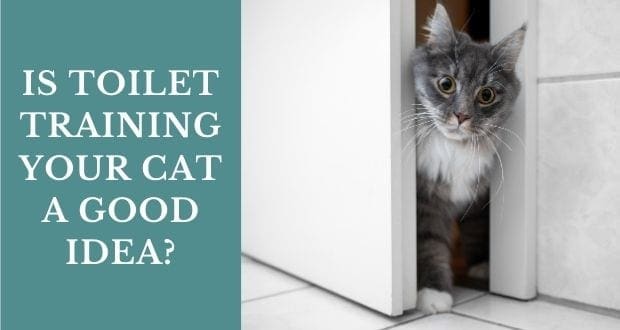
Toilet training your cat may sound like a convenient alternative to the litter box, but don’t be in a rush to get rid of that box without knowing what you and your cat will be facing. There are serious negatives to toilet training and too many people jump on the toilet training band wagon without fully understanding potential downsides to this technique. I have done many consultations for cat behavior problems as a result of cat parents attempting to train their cats to exclusively eliminate in the toilet. The cats end up stressed out and confused, and the human family members almost always wind up very frustrated. What is supposed to be the answer to the dreaded litter box set-up may end up creating a major behavior problem.
Nobody Likes a Litter Box That Stinks
One common reason people are attracted to the idea of toilet training their cats is because they’re fed up with dealing with litter box mess and smell. Many people don’t want to come in contact with what comes out of the rear end of a cat even if that only means scooping the waste a couple of times a day. In reality, litter boxes don’t have to be messy and smelly. A big reason why they are is they don’t get scooped and cleaned enough, or cat parents choose a box that’s too small for the size of the cat. Too any times it’s the cat parent who drops the ball in terms of litter box maintenance. Would you want to use an unflushed toilet? Well, an uncleaned litter box is the feline equivalent to that. Litter granules can only absorb so much urine. A clean and odor-free litter box takes a consistent but easy routine. Scoop out the waste twice a day, periodically top off the box with fresh litter to maintain a consistent level, and then thoroughly scrub the box monthly (more often if not using scoopable litter). Follow that routine and no one will even know there’s a litter box in the room.
Why Toilet Training Isn’t the Best Idea For Your Cat
When the cat eliminates in the toilet you can’t accurately see whether there’s a change in urine or feces volume. You also can’t detect a change in elimination habits. If the urine is going into the toilet as opposed to a litter box, you can’t tell whether there has been an increase or decrease in volume. A change in volume is a big red flag to a potential medical problem. When you scoop the litter box you’re alerted to changes in urine clumps. Early detection may make a huge difference in how successfully potential illness is treated.
Toilet training goes against a cat’s natural instinct to dig, eliminate, and cover. Even indoors cats who have never set one paw outside has this instinct.
The toilet lid must always be left open. The first time someone closes the lid, the cat has no choice but to eliminate on carpet. Imagine how stressful this situation would be for the cat who has no other option when there’s a need to eliminate.
Cats can’t flush so that can cause lingering odor from solid waste. Not everyone in the house wants to go into the bathroom to find feces floating around in the toilet.
Cats in multicat homes may object to sharing the same toilet. In multicat homes it’s important to pay attention to social groups and territorial divisions. Typically, there should be more litter boxes than cats and if you toilet train all your cats it can create stress if they have to share. It may also lead to guarding behavior if one higher-ranking cat doesn’t want other cats to enter that area.
Even though you can purchase commercial toilet training kits, at some point you have to take the kit away and force your cat to straddle the toilet. For some cats, including those who are very young, old, ill, or in pain, this can be difficult and stressful. Toilet seats are slippery and can be difficult for a less-than healthy cat to negotiate.
If your cat falls in the toilet, although he may be able to get out, the panic may cause him to hesitate eliminating in there in the future. Should the cat fall in a dirty toilet, then you have the added stress of having to bathe him. If he’s home alone, he’ll be potentially dealing with the traumatic event for hours by himself.
When hospitalized or boarded, your cat will be put in a cage with a traditional litter box. Once your cat returns home, you may have to retrain to the toilet again. This may cause confusion.
Going to the Bathroom Shouldn’t Cause Stress to Your Cat
The process of eliminating waste shouldn’t be a stressful event for your cat. A litter box filled with an appealing litter most closely resembles what a cat would choose outdoors. Cats dig, eliminate, and cover by instinct. Covering the waste is how they prevent predators from finding where they live. Even indoor cats have that instinct for security. In multicat homes, litter box locations are important when it comes to creating security for each cat. One cat may not feel comfortable going through another cat’s area to get to a litter box. With traditional boxes that can be addressed by locating them in various parts of the house. When you toilet train you’re limited to fixed locations.
What’s the perfect set-up for a cat? Stick to what’s most natural: an absorbent litter in the right sized box that’s kept clean, and located in an appealing area.
Need More Information on Cat Behavior?
For more specifics on creating the ideal litter box set-up or for help with litter box problems, refer to the best-selling books by Pam Johnson-Bennett. Her books are available in bookstores and online. We’ve included Amazon links here on our website.
If you have a question regarding your cat’s health, please contact your veterinarian. This article is not intended as a replacement for your cat’s veterinary care.
 Problem Solving & Advice by Pam Johnson-Bennett Cat Behavior Expert & Best-selling Author
Problem Solving & Advice by Pam Johnson-Bennett Cat Behavior Expert & Best-selling Author




